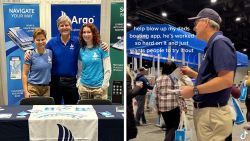For Ohio-based software company Hyland, the recruiting process starts in middle school.
When the business first launched more than two decades ago, hiring was tough. It was hard to find local workers with the necessary skill sets to fill open positions.
“There wasn’t a ready-made workforce for us when we started 20 years ago,” said CEO Bill Priemer.
So the company decided to play the long game by creating its own pipeline of workers. Hyland teamed up with local middle and high schools, as well as higher education institutions, to groom the next generation of tech workers.
Even in the current job-seeker’s market with the unemployment rate at a 49-year low, Hyland’s CEO says the company is on track to hire 300 new people this year, with roughly half being for entry-level positions.

William Yznaga just recently accepted a full-time job offer as a developer at Hyland. His hire was almost a decade in the making.
Yznaga was first exposed to Hyland in middle school on a school field trip. He then participated in an after-school program at the software company while still in high school. And he was a summer intern throughout college.
Finally, a full time job offer came in August.
“Each and every time I was there, I was interacting with employees and got an insider look at the culture,” the 20-year-old said. “I was interacting with employees who were serving as mentors, teaching me and it gave me the opportunity to see what it would be like to work there.”
While recruiting talent is difficult across many industries right now, tech positions have been particularly difficult to fill, especially in the Midwest.
In the top Midwest markets, there were two-to-five jobs per applicant in August, according to data from ZipRecruiter. “There are not enough job seekers in these markets searching for work to fill all the open jobs there,” said CEO Ian Siegel.
To help attract talent, companies are becoming more flexible with when and where their employees work, which has made competition even more stiff.
“There was a time when tech professionals were more likely to seek opportunities in tech ‘hubs’ because cutting-edge organizations were clustered there, but as companies are expanding across the map, so are options for talent and hiring managers,” said Jim Johnson, senior vice president at recruitment company Robert Half Technology. “As organizations become more flexible with candidates working remotely, there is more competition for workers.”
When it comes to filling tech positions, acting quickly is essential. “[Companies] must ensure that job requirements only ask for essential skills and that they ensure a speedy hiring process,” said Johnson. “In the current market, there isn’t room for asking for too much or wasting time when it comes to capable candidates.”
Hyland’s Priemer credits a lot of the company’s hiring success to its relationship with both lower and higher education institutions.
Hyland works with about 25 community colleges and universities in Ohio, Pennsylvania and Michigan.
This past summer, Hyland had 130 college interns, trying to keep pace with its entry-level employee demands.
“We have active intern pipelines, but it is beyond that — we are invited into their classrooms, and co-teaching, guest lecturing and sponsoring team projects,” Priemer said.





















